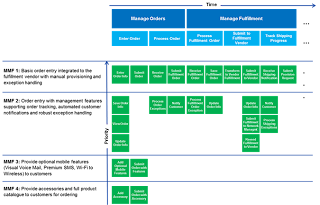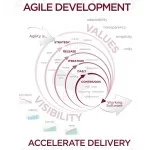Using Story Mapping For Defining Business Requiremets
Approach
To come up with a Story Map, start out by identifying user personas or the major categories of users that gain value from the system. Next, identify the business/user goals or the major objectives that the system must support. For each goal, determine the user activities or the sequential events that the user needs to do in order to get value. Finally, break the activities down into explicit system Features that have real tangible business value.
Once the overall narrative of the system is understood, the Story Map can be used to prioritize the Features. For each of the activities, vertical component can be added to define the priority of the features with respect to each other. Each set of Features for a particular user activity are reshuffled and stacked vertically according to their relative priority. The top row of the Features on the story map represent the backbone of the product, which is the Minimum Marketable Features (MMFs) that are required in order to have a functional product. Features that may be delivered later (or sometimes never) are placed lower down.
Once overall prioritization of Features necessary to support each user activity is understood, the entire Story Map can be divided by planned Releases/Minimum Marketable Features. Horizontal lanes can be used to divide different MMFs from each other. The Story Map can then be used to tell a narrative for a particular MMF. This is done by traversing the map from left to right and only looking at the Features within a particular lane.
Story Mapping enables both a top-down and bottom-up perspective of the system to emerge. It facilitates understanding of the system from the users’ perspective. It also lends itself to iterative delivery in that prioritization and grouping of Features into Releases/Minimum Marketable Features is supported.
Don’t forget to share!
Reference: Using Story Mapping For Defining Business Requiremets from our JCG partner Alexis Hui at the Lean Transformation blog.





